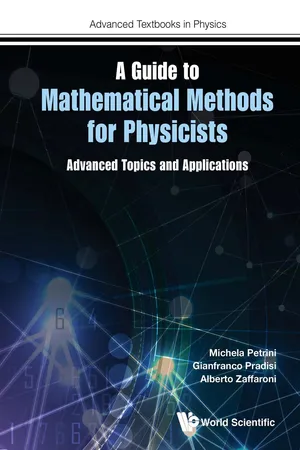
A Guide to Mathematical Methods for Physicists
Advanced Topics and Applications
- 308 pages
- English
- ePUB (mobile friendly)
- Available on iOS & Android
A Guide to Mathematical Methods for Physicists
Advanced Topics and Applications
About this book
This book provides a self-contained and rigorous presentation of the main mathematical tools needed to approach many courses at the last year of undergraduate in Physics and MSc programs, from Electromagnetism to Quantum Mechanics. It complements A Guide to Mathematical Methods for Physicists with advanced topics and physical applications. The different arguments are organised in three main sections: Complex Analysis, Differential Equations and Hilbert Spaces, covering most of the standard mathematical method tools in modern physics.
One of the purposes of the book is to show how seemingly different mathematical tools like, for instance, Fourier transforms, eigenvalue problems, special functions and so on, are all deeply interconnected. It contains a large number of examples, problems and detailed solutions, emphasising the main purpose of relating concrete physical examples with more formal mathematical aspects.
Contents:
- Complex Analysis:
- Introduction
- Mapping Properties of Holomorphic Functions
- Laplace Transform
- Asymptotic Expansions
- Differential Equations:
- Introduction
- The Cauchy Problem for Differential Equations
- Boundary Value Problems
- Green Functions
- Power Series Methods
- Hilbert Spaces:
- Introduction
- Compact Operators and Integral Equations
- Hilbert Spaces and Quantum Mechanics
- Appendices:
- Review of Basic Concepts
- Solutions of the Exercises
Readership: Students and professionals in the field.
Mathematical Methods0 Key Features:
- This book treats the chosen topics in depth, always keeping in mind physical applications and practical aspects
- The book contains many examples and exercises with solutions. This is of course of practical use for the students, and it is also meant to stress the main purpose of relating concrete physical examples with more formal mathematical aspects
Frequently asked questions
- Essential is ideal for learners and professionals who enjoy exploring a wide range of subjects. Access the Essential Library with 800,000+ trusted titles and best-sellers across business, personal growth, and the humanities. Includes unlimited reading time and Standard Read Aloud voice.
- Complete: Perfect for advanced learners and researchers needing full, unrestricted access. Unlock 1.4M+ books across hundreds of subjects, including academic and specialized titles. The Complete Plan also includes advanced features like Premium Read Aloud and Research Assistant.
Please note we cannot support devices running on iOS 13 and Android 7 or earlier. Learn more about using the app.
Information
PART I
Complex Analysis
Introduction





Table of contents
- Cover Page
- Title Page
- Copyright Page
- Preface
- Contents
- Part I. Complex Analysis
- Part II. Differential Equations
- Part III. Hilbert Spaces
- Part IV. Appendices
- Bibliography
- Index